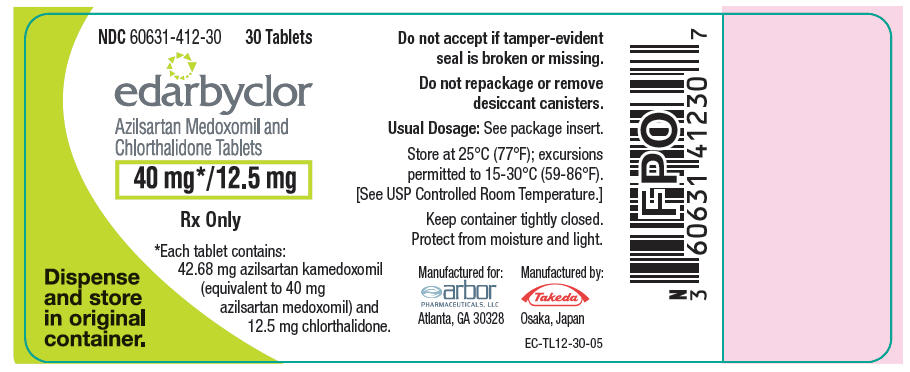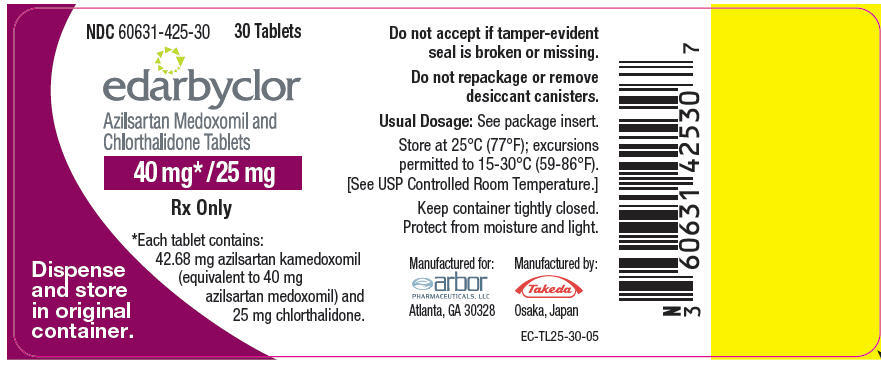EDARBYCLOR- azilsartan kamedoxomil and chlorthalidone tablet
Edarbyclor by
Drug Labeling and Warnings
Edarbyclor by is a Prescription medication manufactured, distributed, or labeled by Arbor Pharmaceuticals. Drug facts, warnings, and ingredients follow.
Drug Details [pdf]
-
HIGHLIGHTS OF PRESCRIBING INFORMATION
These highlights do not include all the information needed to use EDARBYCLOR safely and effectively. See full prescribing information for EDARBYCLOR.
EDARBYCLOR (azilsartan medoxomil and chlorthalidone) tablets, for oral use
Initial U.S. Approval: 2011RECENT MAJOR CHANGES
Contraindications (4) 10/2016 INDICATIONS AND USAGE
Edarbyclor is an angiotensin II receptor blocker (ARB) and a thiazide-like diuretic combination product indicated for the treatment of hypertension, to lower blood pressure:
- In patients not adequately controlled with monotherapy (1)
- As initial therapy in patients likely to need multiple drugs to help achieve blood pressure goals (1)
Lowering blood pressure reduces the risk of fatal and nonfatal cardiovascular events, primarily strokes and myocardial infarctions (1)
DOSAGE AND ADMINISTRATION
- Starting dose is 40/12.5 mg once daily (2.1)
- Edarbyclor may be used to provide additional blood pressure lowering for patients not adequately controlled on azilsartan medoxomil 80 mg or chlorthalidone 25 mg (2.1)
- Dose may be increased to 40/25 mg after 2 to 4 weeks as needed to achieve blood pressure goals (2.1)
- Maximal dose is 40/25 mg (2.1)
- May be administered with other antihypertensive agents (2.1)
- Edarbyclor may be administered with or without food (2.1)
- Replace volume in volume-depleted patients prior to use (2.2)
DOSAGE FORMS AND STRENGTHS
Tablets (azilsartan/chlorthalidone): 40/12.5 mg and 40/25 mg (3)
CONTRAINDICATIONS
WARNINGS AND PRECAUTIONS
- In patients with an activated renin-angiotensin-aldosterone system (RAAS), such as volume- and/or salt-depleted patients, Edarbyclor can cause excessive hypotension. Correct volume or salt depletion prior to administration of Edarbyclor (5.2)
- In patients with renal artery stenosis, Edarbyclor may cause renal failure (5.3)
- Monitor renal function in patients with renal impairment. Consider discontinuing Edarbyclor with progressive renal impairment (5.3)
- Monitor serum electrolytes periodically (5.4)
ADVERSE REACTIONS
Most common adverse reactions (incidence ≥2%) are dizziness and fatigue (6.1)
To report SUSPECTED ADVERSE REACTIONS, contact Arbor Pharmaceuticals, LLC at 1-866-516-4950 or FDA at 1-800-FDA-1088 or www.fda.gov/medwatch.
DRUG INTERACTIONS
- Renal clearance of lithium is reduced by diuretics, such as chlorthalidone increasing the risk of lithium toxicity (7)
- NSAIDS increase risk of renal dysfunction and interfere with antihypertensive effect (7)
- Dual inhibition of the renin-angiotensin system: Increased risk of renal impairment, hypotension, and hyperkalemia (7)
- Lithium: Increases in serum lithium concentrations and lithium toxicity (7)
See 17 for PATIENT COUNSELING INFORMATION and FDA-approved patient labeling.
Revised: 10/2016
-
Table of Contents
FULL PRESCRIBING INFORMATION: CONTENTS*
WARNING: FETAL TOXICITY
1 INDICATIONS AND USAGE
2 DOSAGE AND ADMINISTRATION
2.1 Dosing Information
2.2 Prior to Dosing
2.3 Handling Instructions
3 DOSAGE FORMS AND STRENGTHS
4 CONTRAINDICATIONS
5 WARNINGS AND PRECAUTIONS
5.1 Fetal Toxicity
5.2 Hypotension in Volume- or Salt-Depleted Patients
5.3 Impaired Renal Function
5.4 Serum Electrolyte Imbalances
5.5 Hyperuricemia
6 ADVERSE REACTIONS
6.1 Clinical Trials Experience
6.2 Postmarketing Experience
7 DRUG INTERACTIONS
8 USE IN SPECIFIC POPULATIONS
8.1 Pregnancy
8.3 Nursing Mothers
8.4 Pediatric Use
8.5 Geriatric Use
8.6 Renal Impairment
8.7 Hepatic Impairment
10 OVERDOSAGE
11 DESCRIPTION
12 CLINICAL PHARMACOLOGY
12.1 Mechanism of Action
12.2 Pharmacodynamics
12.3 Pharmacokinetics
13 NONCLINICAL TOXICOLOGY
13.1 Carcinogenesis, Mutagenesis, Impairment of Fertility
13.2 Animal Toxicology and/or Pharmacology
14 CLINICAL STUDIES
16 HOW SUPPLIED/STORAGE AND HANDLING
17 PATIENT COUNSELING INFORMATION
- * Sections or subsections omitted from the full prescribing information are not listed.
-
BOXED WARNING
(What is this?)
WARNING: FETAL TOXICITY
- When pregnancy is detected, discontinue Edarbyclor as soon as possible [see Warnings and Precautions (5.1)].
- Drugs that act directly on the renin-angiotensin system can cause injury and death to the developing fetus [see Warnings and Precautions (5.1)].
-
1 INDICATIONS AND USAGE
Edarbyclor contains an angiotensin II receptor blocker (ARB) and a thiazide-like diuretic and is indicated for the treatment of hypertension, to lower blood pressure.
Edarbyclor may be used in patients whose blood pressure is not adequately controlled on monotherapy.
Edarbyclor may be used as initial therapy if a patient is likely to need multiple drugs to achieve blood pressure goals.
Lowering blood pressure reduces the risk of fatal and nonfatal cardiovascular events, primarily strokes and myocardial infarctions. These benefits have been seen in controlled trials of antihypertensive drugs from a wide variety of pharmacologic classes including thiazide-like diuretics such as chlorthalidone and ARBs such as azilsartan medoxomil. There are no controlled trials demonstrating risk reduction with Edarbyclor.
Control of high blood pressure should be part of comprehensive cardiovascular risk management, including, as appropriate, lipid control, diabetes management, antithrombotic therapy, smoking cessation, exercise, and limited sodium intake. Many patients will require more than one drug to achieve blood pressure goals. For specific advice on goals and management of high blood pressure, see published guidelines, such as those of the National High Blood Pressure Education Program's Joint National Committee on Prevention, Detection, Evaluation, and Treatment of High Blood Pressure (JNC).
Numerous antihypertensive drugs, from a variety of pharmacologic classes and with different mechanisms of action, have been shown in randomized controlled trials to reduce cardiovascular morbidity and mortality, and it can be concluded that it is blood pressure reduction, and not some other pharmacologic property of the drugs, that is largely responsible for those benefits. The largest and most consistent cardiovascular outcome benefit has been a reduction in the risk of stroke, but reductions in myocardial infarction and cardiovascular mortality also have been seen regularly.
Elevated systolic or diastolic pressure causes increased cardiovascular risk, and the absolute risk increase per mmHg is greater at higher blood pressures, so that even modest reductions of severe hypertension can provide substantial benefit. Relative risk reduction from blood pressure reduction is similar across populations with varying absolute risk, so the absolute benefit is greater in patients who are at higher risk independent of their hypertension (for example, patients with diabetes or hyperlipidemia), and such patients would be expected to benefit from more aggressive treatment to a lower blood pressure goal.
Some antihypertensive drugs have smaller blood pressure effects (as monotherapy) in black patients; however, the blood pressure effect of Edarbyclor in blacks is similar to that in non-blacks. Many antihypertensive drugs have additional approved indications and effects (e.g., on angina, heart failure, or diabetic kidney disease). These considerations may guide selection of therapy.
The choice of Edarbyclor as initial therapy for hypertension should be based on an assessment of potential benefits and risks including whether the patient is likely to tolerate the starting dose of Edarbyclor.
Patients with moderate-to-severe hypertension are at a relatively high risk of cardiovascular events (e.g., stroke, heart attack, and heart failure), kidney failure, and vision problems, so prompt treatment is clinically relevant. Consider the patient's baseline blood pressure, target goal and the incremental likelihood of achieving the goal with a combination product, such as Edarbyclor, versus a monotherapy product when deciding upon initial therapy. Individual blood pressure goals may vary based on the patient's risk.
Data from an 8-week, active-controlled, factorial trial provide estimates of the probability of reaching a target blood pressure with Edarbyclor compared with azilsartan medoxomil or chlorthalidone monotherapy [see Clinical Studies (14)].
Figures 1.a-1.d provide estimates of the likelihood of achieving target clinic systolic and diastolic blood pressure control with Edarbyclor 40/25 mg tablets after 8 weeks, based on baseline systolic or diastolic blood pressure. The curve for each treatment group was estimated by logistic regression modeling and is more variable at the tails.
Figure 1.a Probability of Achieving Systolic Blood Pressure <140 mmHg at Week 8 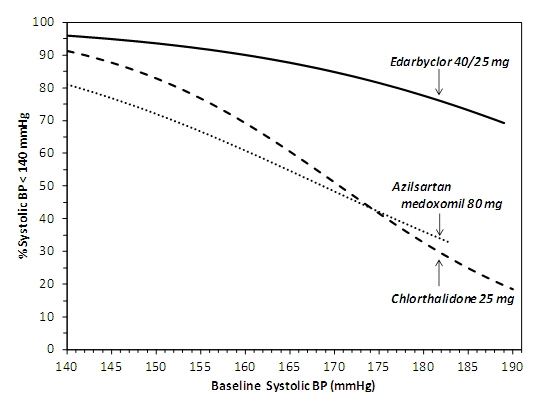
Figure 1.b Probability of Achieving Systolic Blood Pressure <130 mmHg at Week 8 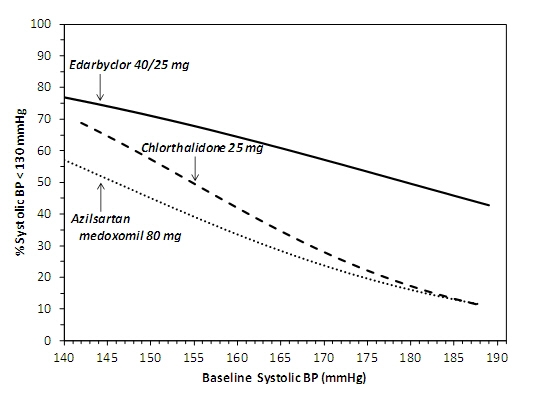
Figure 1.c Probability of Achieving Diastolic Blood Pressure <90 mmHg at Week 8 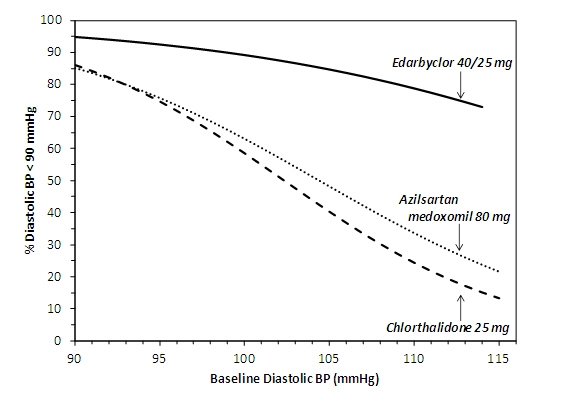
Figure 1.d Probability of Achieving Diastolic Blood Pressure <80 mmHg at Week 8 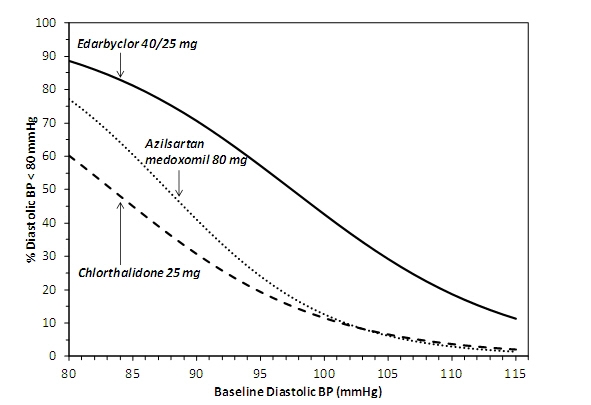
For example, a patient with a baseline blood pressure of 170/105 mm Hg has approximately a 48% likelihood of achieving a goal of <140 mm Hg (systolic) and 48% likelihood of achieving <90 mm Hg (diastolic) on azilsartan medoxomil 80 mg. The likelihood of achieving these same goals on chlorthalidone 25 mg is approximately 51% (systolic) and 40% (diastolic). These likelihoods rise to 85% (systolic) and 85% (diastolic) with Edarbyclor 40/25 mg.
-
2 DOSAGE AND ADMINISTRATION
2.1 Dosing Information
The recommended starting dose of Edarbyclor is 40/12.5 mg taken orally once daily. Most of the antihypertensive effect is apparent within 1 to 2 weeks. The dosage may be increased to 40/25 mg after 2 to 4 weeks as needed to achieve blood pressure goals. Edarbyclor doses above 40/25 mg are probably not useful.
Edarbyclor may be used to provide additional blood pressure lowering for patients not adequately controlled on ARB or diuretic monotherapy treatment. Patients not controlled with azilsartan medoxomil 80 mg may have an additional systolic / diastolic clinic blood pressure reduction of 13/6 mm Hg when switched to Edarbyclor 40/12.5 mg. Patients not controlled with chlorthalidone 25 mg may have an additional clinic blood pressure reduction of 10/7 mm Hg when switched to Edarbyclor 40/12.5 mg.
Edarbyclor may be used as initial therapy if a patient is likely to need multiple drugs to achieve blood pressure goals.
Patients titrated to the individual components (azilsartan medoxomil and chlorthalidone) may instead receive the corresponding dose of Edarbyclor.
Edarbyclor may be taken with or without food [see Clinical Pharmacology (12.3)].
Edarbyclor may be administered with other antihypertensive agents as needed.
2.2 Prior to Dosing
Correct any volume depletion prior to administration of Edarbyclor, particularly in patients with impaired renal function or those treated with high doses of diuretics [see Warnings and Precautions (5.2)].
Patients who experience dose-limiting adverse reactions on chlorthalidone may be switched to Edarbyclor, initially with a lower dose of chlorthalidone [see Warnings and Precautions (5.4)].
-
3 DOSAGE FORMS AND STRENGTHS
Edarbyclor is supplied in the following dosage strengths:
- 40/12.5 mg: pale red, round, biconvex, film-coated tablets, approximately 9.7 mm in diameter, with "A/C" and "40/12.5" imprinted on one side. Each tablet contains 40 mg of azilsartan medoxomil and 12.5 mg of chlorthalidone.
- 40/25 mg: light red, round, biconvex, film-coated tablets, approximately 9.7 mm in diameter, with "A/C" and "40/25" imprinted on one side. Each tablet contains 40 mg of azilsartan medoxomil and 25 mg of chlorthalidone.
-
4 CONTRAINDICATIONS
- Edarbyclor is contraindicated in patients with anuria [see Warnings and Precautions (5.3)].
- Do not coadminister aliskiren-containing products with Edarbyclor in patients with diabetes [see Drug Interactions (7)].
-
5 WARNINGS AND PRECAUTIONS
5.1 Fetal Toxicity
Azilsartan medoxomil
Use of drugs that act on the renin-angiotensin system during the second and third trimesters of pregnancy reduces fetal renal function and increases fetal and neonatal morbidity and death. Resulting oligohydramnios can be associated with fetal lung hypoplasia and skeletal deformations. Potential neonatal adverse effects include skull hypoplasia, anuria, hypotension, renal failure, and death. When pregnancy is detected, discontinue Edarbyclor as soon as possible [see Use in Specific Populations (8.1)].
5.2 Hypotension in Volume- or Salt-Depleted Patients
In patients with an activated renin-angiotensin system, such as volume- or salt-depleted patients (e.g., those being treated with high doses of diuretics), symptomatic hypotension may occur after initiation of treatment with Edarbyclor. Such patients are probably not good candidates to start therapy with more than one drug; therefore, correct volume prior to administration of Edarbyclor. If hypotension does occur, the patient should be placed in the supine position and, if necessary, given an intravenous infusion of normal saline. A transient hypotensive response is not a contraindication to further treatment, which usually can be continued without difficulty once the blood pressure has stabilized.
5.3 Impaired Renal Function
Edarbyclor
Monitor for worsening renal function in patients with renal impairment. Consider withholding or discontinuing Edarbyclor if progressive renal impairment becomes evident.
Azilsartan medoxomil
As a consequence of inhibiting the renin-angiotensin system, changes in renal function may be anticipated in susceptible individuals treated with Edarbyclor. In patients whose renal function may depend on the activity of the renin-angiotensin system (e.g., patients with severe congestive heart failure, renal artery stenosis, or volume depletion), treatment with angiotensin-converting enzyme inhibitors and angiotensin receptor blockers has been associated with oliguria or progressive azotemia and rarely with acute renal failure and death. Similar results may be anticipated in patients treated with Edarbyclor [see Drug Interactions (7), Use in Specific Populations (8.6) and Clinical Pharmacology (12.3)].
In studies of ACE inhibitors in patients with unilateral or bilateral renal artery stenosis, increases in serum creatinine or blood urea nitrogen have been reported. There has been no long-term use of azilsartan medoxomil in patients with unilateral or bilateral renal artery stenosis, but similar results are expected.
5.4 Serum Electrolyte Imbalances
Thiazide diuretics can cause hyponatremia and hypokalemia. Drugs that inhibit the renin angiotensin system can cause hyperkalemia. Hypokalemia is a dose-dependent adverse reaction that may develop with chlorthalidone. Co-administration of digitalis may exacerbate the adverse effects of hypokalemia. Monitor serum electrolytes periodically.
Edarbyclor attenuates chlorthalidone-associated hypokalemia. In patients with normal potassium levels at baseline, 1.7% of Edarbyclor-treated patients, 0.9% of azilsartan medoxomil-treated patients, and 13.4% of chlorthalidone-treated patients shifted to low potassium values (less than 3.4 mmol/L).
-
6 ADVERSE REACTIONS
The following potential adverse reactions with Edarbyclor, azilsartan medoxomil, or chlorthalidone and similar agents are included in more detail in the Warnings and Precautions section of the label:
- Fetal toxicity [see Warnings and Precautions (5.1)]
- Hypotension in Volume- or Salt-Depleted Patients [see Warnings and Precautions (5.2)]
- Impaired Renal Function [see Warnings and Precautions (5.3)]
- Hypokalemia [see Warnings and Precautions (5.4)]
- Hyperuricemia [see Warnings and Precautions (5.5)]
6.1 Clinical Trials Experience
Because clinical trials are conducted under widely varying conditions, adverse reaction rates observed in the clinical trials of a drug cannot be directly compared to rates in the clinical trials of another drug and may not reflect the rates observed in practice.
Edarbyclor has been evaluated for safety in more than 3900 patients with hypertension; more than 700 patients were treated for at least 6 months and more than 280 for at least 1 year. Adverse reactions have generally been mild and transient in nature.
Common adverse reactions that occurred in the 8-week factorial design trial in at least 2% of Edarbyclor-treated patients and greater than azilsartan medoxomil or chlorthalidone are presented in Table 1.
Table 1. Adverse Reactions Occurring at an Incidence of ≥2% of Edarbyclor-treated Patients and > Azilsartan medoxomil or Chlorthalidone Preferred Term Azilsartan medoxomil
20, 40, 80 mg
(N=470)Chlorthalidone
12.5, 25 mg
(N=316)Edarbyclor
40 / 12.5, 40 / 25 mg
(N=302)Dizziness 1.7% 1.9% 8.9% Fatigue 0.6% 1.3% 2.0% Hypotension and syncope were reported in 1.7% and 0.3%, respectively, of patients treated with Edarbyclor.
Study discontinuation because of adverse reactions occurred in 8.3% of patients treated with the recommended doses of Edarbyclor compared with 3.2% of patients treated with azilsartan medoxomil and 3.2% of patients treated with chlorthalidone. The most common reasons for discontinuation of therapy with Edarbyclor were serum creatinine increased (3.6%) and dizziness (2.3%).
The adverse reaction profile obtained from 52 weeks of open-label combination therapy with azilsartan medoxomil plus chlorthalidone or Edarbyclor was similar to that observed during the double-blind, active controlled trials.
In 3 double-blind, active controlled, titration studies, in which Edarbyclor was titrated to higher doses in a step-wise manner, adverse reactions and discontinuations for adverse events were less frequent than in the fixed-dose factorial trial.
Azilsartan medoxomil
A total of 4814 patients were evaluated for safety when treated with azilsartan medoxomil at doses of 20, 40 or 80 mg in clinical trials. This includes 1704 patients treated for at least 6 months, of these, 588 were treated for at least 1 year. Generally, adverse reactions were mild, not dose related and similar regardless of age, gender and race.
Adverse reactions with a plausible relationship to treatment that have been reported with an incidence of ≥0.3% and greater than placebo in more than 3300 patients treated with azilsartan medoxomil in controlled trials are listed below:
Gastrointestinal Disorders: diarrhea, nausea
General Disorders and Administration Site Conditions: asthenia, fatigue
Musculoskeletal and Connective Tissue Disorders: muscle spasm
Nervous System Disorders: dizziness, dizziness postural
Respiratory, Thoracic and Mediastinal Disorders: cough
Chlorthalidone
The following adverse reactions have been observed in clinical trials of chlorthalidone: rash, headache, dizziness, GI upset, and elevations of uric acid and cholesterol.
Clinical Laboratory Findings with Edarbyclor
In the factorial design trial, clinically relevant changes in standard laboratory parameters were uncommon with administration of the recommended doses of Edarbyclor.
Renal parameters:
Increased blood creatinine is a known pharmacologic effect of renin-angiotensin aldosterone system (RAAS) blockers, such as ARBs and ACE inhibitors, and is related to the magnitude of blood pressure reduction. The incidence of consecutive increases of creatinine ≥50% from baseline and >ULN was 2.0% in patients treated with the recommended doses of Edarbyclor compared with 0.4% and 0.3% with azilsartan medoxomil and chlorthalidone, respectively. Elevations of creatinine were typically transient, or non-progressive and reversible, and associated with large blood pressure reductions.
Mean increases in blood urea nitrogen (BUN) were observed with Edarbyclor (5.3 mg/dL) compared with azilsartan medoxomil (1.5 mg/dL) and with chlorthalidone (2.5 mg/dL).
6.2 Postmarketing Experience
The following adverse reactions have been identified during the postmarketing use of EDARBYCLOR. Because these reactions are reported voluntarily from a population of uncertain size, it is not always possible to reliably estimate their frequency or establish a causal relationship to drug exposure.
- Nausea
- Syncope
- Loss of consciousness
- Rash
- Pruritus
- Angioedema
-
7 DRUG INTERACTIONS
Edarbyclor
The pharmacokinetics of azilsartan medoxomil and chlorthalidone are not altered when the drugs are co-administered.
No drug interaction studies have been conducted with other drugs and Edarbyclor, although studies have been conducted with azilsartan medoxomil and chlorthalidone.
Azilsartan medoxomil
No clinically significant drug interactions have been observed in studies of azilsartan medoxomil or azilsartan given with amlodipine, antacids, chlorthalidone, digoxin, fluconazole, glyburide, ketoconazole, metformin, pioglitazone, and warfarin. Therefore, azilsartan medoxomil may be used concomitantly with these medications.
Non-Steroidal Anti-Inflammatory Agents including Selective Cyclooxygenase-2 Inhibitors (COX-2 Inhibitors)
In patients who are elderly, volume-depleted (including those on diuretic therapy), or who have compromised renal function, co-administration of NSAIDs, including selective COX-2 inhibitors, with angiotensin II receptor antagonists, including azilsartan, may result in deterioration of renal function, including possible acute renal failure. These effects are usually reversible. Monitor renal function periodically in patients receiving Edarbyclor and NSAID therapy.
The antihypertensive effect of Edarbyclor may be attenuated by NSAIDs, including selective COX-2 inhibitors.
Dual Blockade of the Renin-Angiotensin System (RAS)
Dual blockade of the RAS with angiotensin receptor blockers, ACE inhibitors, or aliskiren is associated with increased risks of hypotension, hyperkalemia, and changes in renal function (including acute renal failure) compared to monotherapy. Most patients receiving the combination of two RAS inhibitors do not obtain any additional benefit compared to monotherapy. In general, avoid combined use of RAS inhibitors. Closely monitor blood pressure, renal function and electrolytes in patients on Edarbyclor and other agents that affect the RAS.
Do not coadminister aliskiren with Edarbyclor in patients with diabetes. Avoid use of aliskiren with Edarbyclor in patients with renal impairment (GFR <60 mL/min).
-
8 USE IN SPECIFIC POPULATIONS
8.1 Pregnancy
Pregnancy Category D
Use of drugs that affect the renin-angiotensin system during the second and third trimesters of pregnancy reduces fetal renal function and increases fetal and neonatal morbidity and death. Resulting oligohydramnios can be associated with fetal lung hypoplasia and skeletal deformations. Potential neonatal adverse effects include skull hypoplasia, anuria, hypotension, renal failure, and death. When pregnancy is detected, discontinue Edarbyclor as soon as possible. These adverse outcomes are usually associated with use of these drugs in the second and third trimester of pregnancy. Most epidemiologic studies examining fetal abnormalities after exposure to antihypertensive use in the first trimester have not distinguished drugs affecting the renin-angiotensin system from other antihypertensive agents. Appropriate management of maternal hypertension during pregnancy is important to optimize outcomes for both mother and fetus.
In the unusual case that there is no appropriate alternative to therapy with drugs affecting the renin-angiotensin system for a particular patient, apprise the mother of the potential risk to the fetus. Perform serial ultrasound examinations to assess the intra-amniotic environment. If oligohydramnios is observed, discontinue Edarbyclor, unless it is considered lifesaving for the mother. Fetal testing may be appropriate, based on the week of pregnancy. Patients and physicians should be aware, however, that oligohydramnios may not appear until after the fetus has sustained irreversible injury. Closely observe infants with histories of in utero exposure to Edarbyclor for hypotension, oliguria, and hyperkalemia [see Use in Specific Populations (8.4)].
8.3 Nursing Mothers
It is not known if azilsartan is excreted in human milk, but azilsartan is excreted at low concentrations in the milk of lactating rats and thiazide-like diuretics like chlorthalidone are excreted in human milk. Because of the potential for adverse effects on the nursing infant, a decision should be made whether to discontinue nursing or discontinue the drug, taking into account the importance of the drug to the mother.
8.4 Pediatric Use
Safety and effectiveness of Edarbyclor in pediatric patients under 18 years of age have not been established.
8.5 Geriatric Use
Edarbyclor
No dose adjustment with Edarbyclor is necessary in elderly patients. Of the total patients in clinical studies with Edarbyclor, 24% were elderly (65 years of age or older); 5.7% were 75 years and older. No overall differences in safety or effectiveness were observed between elderly patients and younger patients, but greater sensitivity of some older individuals cannot be ruled out [see Clinical Pharmacology (12.3)].
8.6 Renal Impairment
8.7 Hepatic Impairment
Azilsartan medoxomil
No dose adjustment is necessary for subjects with mild or moderate hepatic impairment. Azilsartan medoxomil has not been studied in patients with severe hepatic impairment [see Clinical Pharmacology (12.3)].
-
10 OVERDOSAGE
Limited data are available related to overdosage in humans.
Azilsartan medoxomil
Limited data are available related to overdosage in humans. During controlled clinical trials in healthy subjects, once daily doses up to 320 mg of azilsartan medoxomil were administered for 7 days and were well tolerated. In the event of an overdose, supportive therapy should be instituted as dictated by the patient's clinical status. Azilsartan is not dialyzable.
Chlorthalidone
Symptoms of acute overdosage include nausea, weakness, dizziness, and disturbances of electrolyte balance. The oral LD50 of the drug in the mouse and the rat is more than 25,000 mg/kg body weight. The minimum lethal dose (MLD) in humans has not been established. There is no specific antidote, but gastric lavage is recommended, followed by supportive treatment. Where necessary, this may include intravenous dextrose-saline with potassium, administered with caution.
-
11 DESCRIPTION
Edarbyclor is a combination of azilsartan medoxomil (ARB; as its potassium salt) and chlorthalidone (thiazide-like diuretic).
Azilsartan medoxomil, a prodrug, is hydrolyzed to azilsartan in the gastrointestinal tract during absorption. Azilsartan is a selective AT1 subtype angiotensin II receptor antagonist. Chlorthalidone is a monosulfamyl thiazide-like diuretic that differs chemically from thiazide diuretics by the lack of a benzothiadiazine structure.
The potassium salt of azilsartan medoxomil, azilsartan kamedoxomil, is chemically described as (5-Methyl-2-oxo-1,3-dioxol-4-yl)methyl 2-ethoxy-1-{[2'-(5-oxo-4,5-dihydro-1,2,4-oxadiazol-3-yl)biphenyl-4-yl]methyl}-1H-benzimidazole-7-carboxylate monopotassium salt. Its empirical formula is C30H23KN4O8.
Chlorthalidone is chemically described as 2-chloro-5(1-hydroxy-3-oxo-1- isoindolinyl) benzenesulfonamide. Its empirical formula is C14H11CIN2O4S.
The structural formula for azilsartan medoxomil is
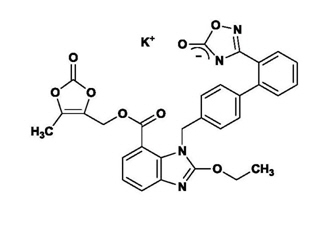
The structural formula for chlorthalidone is
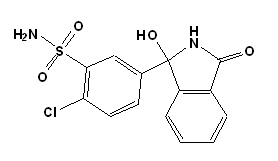
Azilsartan kamedoxomil is a white to nearly white powder with a molecular weight of 606.62. It is practically insoluble in water and freely soluble in methanol.
Chlorthalidone is a white to yellowish white powder with a molecular weight of 338.76. Chlorthalidone is practically insoluble in water, in ether, and in chloroform; soluble in methanol; slightly soluble in ethanol.
Edarbyclor is available for oral use as tablets. The tablets have a characteristic odor. Each Edarbyclor tablet contains 42.68 mg of azilsartan kamedoxomil, which is equivalent to containing azilsartan medoxomil 40 mg plus 12.5 or 25 mg of chlorthalidone. Each tablet of Edarbyclor also contains the following inactive ingredients: mannitol, microcrystalline cellulose, fumaric acid, sodium hydroxide, hydroxypropyl cellulose, crospovidone, magnesium stearate, hypromellose 2910, talc, titanium dioxide, ferric oxide red, polyethylene glycol 8000, and printing ink gray F1.
-
12 CLINICAL PHARMACOLOGY
12.1 Mechanism of Action
The active ingredients of Edarbyclor target two separate mechanisms involved in blood pressure regulation.
Azilsartan medoxomil
Angiotensin II is formed from angiotensin I in a reaction catalyzed by angiotensin-converting enzymes (ACE, kinase II). Angiotensin II is the principle pressor agent of the renin-angiotensin system, with effects that include vasoconstriction, stimulation of synthesis and release of aldosterone, cardiac stimulation, and renal reabsorption of sodium. Azilsartan medoxomil is an orally administered prodrug that is rapidly converted by esterases during absorption to the active moiety, azilsartan. Azilsartan blocks the vasoconstrictor and aldosterone-secreting effects of angiotensin II by selectively blocking the binding of angiotensin II to the AT1 receptor in many tissues, such as vascular smooth muscle and the adrenal gland. Its action is, therefore, independent of the pathway for angiotensin II synthesis.
An AT2 receptor is also found in many tissues, but this receptor is not known to be associated with cardiovascular homeostasis. Azilsartan has more than a 10,000-fold greater affinity for the AT1 receptor than for the AT2 receptor.
Blockade of the renin-angiotensin system with ACE inhibitors, which inhibit the biosynthesis of angiotensin II from angiotensin I, is widely used in the treatment of hypertension. ACE inhibitors also inhibit the degradation of bradykinin, a reaction catalyzed by ACE. Because azilsartan does not inhibit ACE (kinase II), it should not affect bradykinin levels. Whether this difference has clinical relevance is not yet known. Azilsartan does not bind to or block other receptors or ion channels known to be important in cardiovascular regulation.
Blockade of the angiotensin II receptor inhibits the negative regulatory feedback of angiotensin II on renin secretion, but the resulting increased plasma renin activity and angiotensin II circulating levels do not overcome the effect of azilsartan on blood pressure.
Chlorthalidone
Chlorthalidone produces diuresis with increased excretion of sodium and chloride. The site of action appears to be the distal renal tubule (early convoluted part), inhibiting NaCl reabsorption (by antagonizing the Na+-Cl-cotransporter) and promoting Ca++ reabsorption (by an unknown mechanism). The enhanced delivery of Na+ and water to the cortical collecting tubule and/or the increased flow rate leads to increased secretion and elimination of K+ and H+. The diuretic effects of chlorthalildone lead to decreased extracellular fluid volume, plasma volume, cardiac output, total exchangeable sodium, glomerular filtration rate, and renal plasma flow. Although the mechanism of action of chlorthalidone and related drugs is not wholly clear, sodium and water depletion appear to provide a basis for its antihypertensive effect.
12.2 Pharmacodynamics
Edarbyclor
Edarbyclor tablets have been shown to be effective in lowering blood pressure. Both azilsartan medoxomil and chlorthalidone lower blood pressure by reducing peripheral resistance but through complementary mechanisms.
Azilsartan medoxomil
Azilsartan inhibits the pressor effects of an angiotensin II infusion in a dose-related manner. An azilsartan single dose equivalent to 32 mg azilsartan medoxomil inhibited the maximal pressor effect by approximately 90% at peak, and approximately 60% at 24 hours. Plasma angiotensin I and II concentrations and plasma renin activity increased while plasma aldosterone concentrations decreased after single and repeated administration of azilsartan medoxomil to healthy subjects; no clinically significant effects on serum potassium or sodium were observed.
12.3 Pharmacokinetics
Edarbyclor
Following oral administration of Edarbyclor, peak plasma concentrations of azilsartan and chlorthalidone are reached at 3 and 1 hours, respectively. The rate (Cmax and Tmax) and extent (AUC) of absorption of azilsartan are similar when it is administered alone or with chlorthalidone. The extent (AUC) of absorption of chlorthalidone is similar when it is administered alone or with azilsartan medoxomil; however, the Cmax of chlorthalidone from Edarbyclor was 45-47% higher.
There is no clinically significant effect of food on the bioavailability of azilsartan or chlorthalidone following administration of Edarbyclor.
Azilsartan medoxomil
Absorption: Azilsartan medoxomil is an orally administered prodrug that is rapidly converted by esterases during absorption to the active moiety, azilsartan. Azilsartan medoxomil is not detected in plasma after oral administration. Dose proportionality in exposure was established for azilsartan in the azilsartan medoxomil dose range of 20 mg to 320 mg after single or multiple dosing.
The estimated absolute bioavailability of azilsartan following administration of azilsartan medoxomil is approximately 60%. After oral administration of azilsartan medoxomil, peak plasma concentrations (Cmax) of azilsartan are reached within 1.5 to 3 hours. Food does not affect the bioavailability of azilsartan.
Distribution
Azilsartan medoxomil: The volume of distribution of azilsartan is approximately 16L. Azilsartan is highly bound to human plasma proteins (>99%), mainly serum albumin. Protein binding is constant at azilsartan plasma concentrations well above the range achieved with recommended doses.
In rats, minimal azilsartan-associated radioactivity crossed the blood-brain barrier. Azilsartan passed across the placental barrier in pregnant rats and was distributed to the fetus.
Chlorthalidone: In whole blood, chlorthalidone is predominantly bound to erythrocyte carbonic anhydrase. In the plasma, approximately 75% of chlorthalidone is bound to plasma proteins, 58% of the drug being bound to albumin. Chlorthalidone crosses the placental barrier and passes into breast milk. When mothers were treated before and after birth with 50 mg chlorthalidone daily, chlorthalidone levels in fetal whole blood were around 15% of those found in maternal blood. Chlorthalidone concentrations in amniotic fluid and breast milk are approximately 4% of those found in maternal blood.
Metabolism and Elimination
Azilsartan medoxomil: Azilsartan medoxomil, when administered alone or in combination with chlorthalidone is eliminated from plasma with an elimination half-life of 11-13 hours. Azilsartan is metabolized to two primary metabolites. The major metabolite in plasma is formed by O-dealkylation, referred to as metabolite M-II, and the minor metabolite is formed by decarboxylation, referred to as metabolite M-I. Systemic exposures to the major and minor metabolites in humans were approximately 50% and less than 1% of azilsartan, respectively. M-I and M-II do not contribute to the pharmacologic activity of azilsartan medoxomil. The major enzyme responsible for azilsartan metabolism is CYP2C9.
Following an oral dose of 14C-labeled azilsartan medoxomil, approximately 55% of radioactivity was recovered in feces and approximately 42% in urine, with 15% of the dose excreted in urine as azilsartan. The elimination half-life of azilsartan is approximately 11 hours and renal clearance is approximately 2.3 mL/min. Steady-state levels of azilsartan are achieved within 5 days and no accumulation in plasma occurs with repeated once-daily dosing.
Chlorthalidone: Chlorthalidone when administered alone or in combination with azilsartan medoxomil is eliminated from plasma with an elimination half-life of 42-45 hours. The elimination half-life is unaltered following repeat dosing. The majority of an absorbed quantity of chlorthalidone is excreted by the kidneys with a mean renal clearance of 46-70 mL/min. By contrast, metabolism and excretion via the liver and bile play a minor role in the elimination of the substance. Approximately 60%-70% of chlorthalidone is excreted in the urine and feces within 120 hours, mainly in unchanged form.
Special Populations
Azilsartan medoxomil: The effect of demographic and functional factors on the pharmacokinetics of azilsartan was studied in single and multiple dose studies. Pharmacokinetic measures indicating the magnitude of the effect on azilsartan are presented in Figure 2 as change relative to reference (test/reference).
Figure 2. Impact of intrinsic factors on the pharmacokinetics of azilsartan 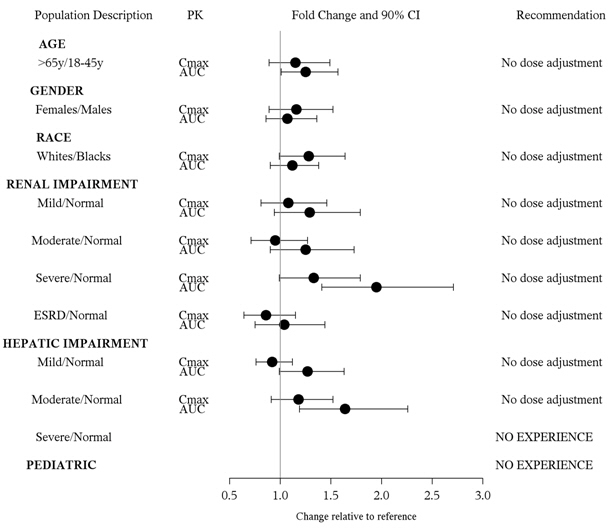
-
13 NONCLINICAL TOXICOLOGY
13.1 Carcinogenesis, Mutagenesis, Impairment of Fertility
No carcinogenicity, mutagenicity, or fertility studies have been conducted with the combination of azilsartan medoxomil and chlorthalidone or with chlorthalidone alone. However, these studies have been conducted for azilsartan medoxomil, azilsartan and M-II.
Azilsartan medoxomil
Carcinogenesis: Azilsartan medoxomil was not carcinogenic when assessed in 26-week transgenic (Tg.rasH2) mouse and 2-year rat studies. The highest doses tested (450 mg azilsartan medoxomil/kg/day in the mouse and 600 mg azilsartan medoxomil/kg/day in the rat) produced exposures to azilsartan that are 12 (mice) and 27 (rats) times the average exposure to azilsartan in humans given the maximum recommended human dose (MRHD, 80 mg azilsartan medoxomil/day). M-II was not carcinogenic when assessed in 26-week Tg.rasH2 mouse and 2-year rat studies. The highest doses tested (approximately 8000 mg M-II/kg/day (males) and 11,000 mg M-II/kg/day (females) in the mouse and 1000 mg M-II/kg/day (males) and up to 3000 mg M-II/kg/day (females) in the rat) produced exposures that are, on average, about 30 (mice) and 7 (rats) times the average exposure to M-II in humans at the MRHD.
Mutagenesis: Chlorthalidone demonstrated no potential for mutagenic effects at non-cytotoxic concentrations and is considered not to pose a mutagenic risk to humans.
Azilsartan medoxomil, azilsartan, and M-II were positive for structural aberrations in the Chinese Hamster Lung Cytogenic Assay. In this assay, structural chromosomal aberrations were observed with the prodrug, azilsartan medoxomil, without metabolic activation. The active moiety, azilsartan, was also positive in this assay both with and without metabolic activation. The major human metabolite, M-II was also positive in this assay during a 24-hr assay without metabolic activation.
Azilsartan medoxomil, azilsartan, and M-II were devoid of genotoxic potential in the Ames reverse mutation assay with Salmonella typhimurium and Escherichia coli, the in vitro Chinese Hamster Ovary Cell forward mutation assay, the in vitro mouse lymphoma (tk) gene mutation test, the ex vivo unscheduled DNA synthesis test, and the in vivo mouse and/or rat bone marrow micronucleus assay.
Impairment of Fertility: Chlorthalidone at a dosage of 100 mg/kg had no effect on fertility in rats. There was no effect of azilsartan medoxomil on the fertility of male or female rats at oral doses of up to 1000 mg azilsartan medoxomil/kg/day [6000 mg/m2 (approximately 122 times the MRHD of 80 mg azilsartan medoxomil/60 kg on a mg/m2 basis)]. Fertility of rats also was unaffected at doses of up to 3000 mg M-II/kg/day.
13.2 Animal Toxicology and/or Pharmacology
Edarbyclor
Repeat dose toxicity
The safety profiles of azilsartan medoxomil and chlorthalidone monotherapy have been individually established. To characterize the toxicological profile for Edarbyclor, a 13-week repeat-dose toxicity study was conducted in rats. The results of this study indicated that the combined administration of azilsartan medoxomil, M-II, and chlorthalidone resulted in increased exposures to chlorthalidone. Pharmacologically-mediated toxicity, including suppression of body weight gain and decreased food consumption in male rats, and increases in blood urea nitrogen in both sexes, was enhanced by coadministration of azilsartan medoxomil, M-II, and chlorthalidone. With the exception of these findings, there were no toxicologically synergistic effects in this study.
In an embryo-fetal developmental study in rats, there was no teratogenicity or increase in fetal mortality in the litters of dams receiving azilsartan medoxomil, M-II and chlorthalidone concomitantly at maternally toxic doses.
Azilsartan medoxomil
Reproductive Toxicology: In peri- and postnatal rat development studies, adverse effects on pup viability, delayed incisor eruption and dilatation of the renal pelvis along with hydronephrosis were seen when azilsartan medoxomil was administered to pregnant and nursing rats at 1.2 times the MRHD on a mg/m2 basis. Reproductive toxicity studies indicated that azilsartan medoxomil was not teratogenic when administered at oral doses up to 1000 mg azilsartan medoxomil/kg/day to pregnant rats (122 times the MRHD on a mg/m2 basis) or up to 50 mg azilsartan medoxomil/kg/day to pregnant rabbits (12 times the MRHD on a mg/m2 basis). M-II also was not teratogenic in rats or rabbits at doses up to 3000 mg M-II/kg/day. Azilsartan crossed the placenta and was found in the fetuses of pregnant rats and was excreted into the milk of lactating rats.
Chlorthalidone
Reproductive toxicology: Reproduction studies have been performed in the rat and the rabbit at doses up to 420 times the human dose and have revealed no evidence of harm to the fetus. Thiazides cross the placental barrier and appear in cord blood.
Pharmacology: Biochemical studies in animals have suggested reasons for the prolonged effect of chlorthalidone. Absorption from the gastrointestinal tract is slow because of its low solubility. After passage to the liver, some of the drug enters the general circulation, while some is excreted in the bile, to be reabsorbed later. In the general circulation, it is distributed widely to the tissue, but is taken up in highest concentrations by the kidneys, where amounts have been found 72 hours after ingestion, long after it has disappeared from other tissues. The drug is excreted unchanged in the urine.
-
14 CLINICAL STUDIES
The antihypertensive effects of Edarbyclor have been demonstrated in a total of 5 randomized controlled studies, which included 4 double-blind, active-controlled studies and 1 open-label, long-term active-controlled study. The studies ranged from 8 weeks to 12 months in duration, at doses ranging from 20/12.5 mg to 80/25 mg once daily. A total of 5310 patients (3082 given Edarbyclor and 2228 given active comparator) with moderate or severe hypertension were studied. Overall, randomized patients had a mean age of 57 years, and included 52% males, 72% whites, 21% blacks, 15% with diabetes, 70% with mild or moderate renal impairment, and a mean BMI of 31.6 kg/m2.
An 8-week, multicenter, randomized, double-blind, active-controlled, parallel group factorial trial in patients with moderate to severe hypertension compared the effect on blood pressure of Edarbyclor with the respective monotherapies. The trial randomized 1714 patients with baseline systolic blood pressure between 160 and 190 mm Hg (mean 165 mm Hg) and a baseline diastolic blood pressure <119 mm Hg (mean 95 mm Hg) to one of the 11 active treatment arms.
The 6 treatment combinations of azilsartan medoxomil 20, 40, or 80 mg and chlorthalidone 12.5 or 25 mg resulted in statistically significant reduction in systolic and diastolic blood pressure as determined by ambulatory blood pressure monitoring (ABPM) (Table 2) and clinic measurement (Table 3) at trough compared with the respective individual monotherapies. The clinic blood pressure reductions appear larger than those observed with ABPM, because the former include a placebo effect, which was not directly measured. Most of the antihypertensive effect of Edarbyclor occurs within 1-2 weeks of dosing. The blood pressure lowering effect was maintained throughout the 24-hour period (Figure 3).
Table 2. Mean Change from Baseline in Systolic/Diastolic Blood Pressure (mm Hg) as Measured by ABPM at Trough (22-24 Hours Post-Dose) at Week 8: Combination Therapy vs Monotherapy Chlorthalidone, mg Azilsartan Medoxomil, mg 0 20 40 80 0 N/A -12 / -8 -13 / -7 -15 / -9 12.5 -13 / -7 -23 / -13 -24 / -14 -26 / -17 25 -16 / -8 -26 / -15 -30 / -17 -28 / -16 Table 3. Mean Change from Baseline in Clinic Systolic/Diastolic Blood Pressure (mm Hg) at Week 8: Combination Therapy vs Monotherapy Chlorthalidone, mg Azilsartan Medoxomil, mg 0 20 40 80 0 N/A -20 / -7 -23 / -9 -24 / -10 12.5 -21 / -7 -34 / -14 -37 / -16 -37 / -17 25 -27 / -9 -37 / - 16 -40 / -17 -40 / -19 Figure 3. Mean Change from Baseline at Week 8 in Ambulatory Systolic Blood Pressure (mm Hg) by Treatment and Hour 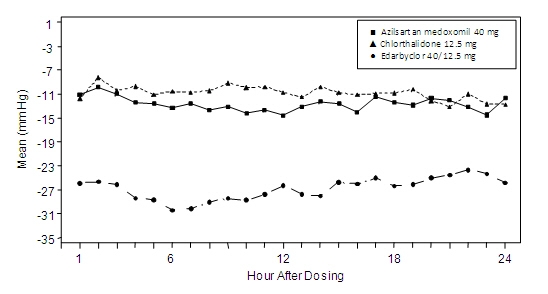
Edarbyclor was effective in reducing blood pressure regardless of age, gender, or race.
Edarbyclor was effective in treating black patients (usually a low-renin population).
In a 12-week, double-blind forced-titration trial, Edarbyclor 40/25 mg was statistically superior (P<0.001) to olmesartan medoxomil – hydrochlorothiazide (OLM/HCTZ) 40/25 mg in reducing systolic blood pressure in patients with moderate to severe hypertension (Table 4). Similar results were observed in all subgroups, including age, gender, or race of patients.
Table 4. Mean Change in Systolic/Diastolic Blood Pressure (mm Hg) at Week 12 Edarbyclor 40/25 mg
N=355OLM/HCTZ 40/25 mg
N=364Clinic
(Mean Baseline 165/96 mm Hg)-43 / -19 -37 / -16 Trough by ABPM (22-24 hours)
(Mean Baseline 153/92 mm Hg)-33 / -20 -26 / -16 Edarbyclor lowered blood pressure more effectively than OLM/HCTZ at each hour of the 24-hour interdosing period as measured by ABPM.
- 16 HOW SUPPLIED/STORAGE AND HANDLING
-
17 PATIENT COUNSELING INFORMATION
See FDA-approved patient labeling (Patient Information).
Tell patients that if they miss a dose, they should take it later in the same day, but not to double the dose on the following day.
Pregnancy
Tell female patients of childbearing potential about the consequences of exposure to Edarbyclor during pregnancy. Discuss treatment options with women planning to become pregnant. Tell patients to report pregnancies to their physicians as soon as possible.
Symptomatic Hypotension
Advise patients to report light-headedness. Advise patients, if syncope occurs, to have someone call the doctor or seek medical attention, and to discontinue Edarbyclor.
Inform patients that dehydration from excessive perspiration, vomiting, or diarrhea may lead to an excessive fall in blood pressure. Inform patients to consult with their healthcare provider if these symptoms occur.
-
PATIENT PACKAGE INSERT
Patient Information
EDARBYCLOR (eh-DAR-bih-clor)
(azilsartan medoxomil and chlorthalidone)
tabletsRead this Patient Information leaflet before you start taking Edarbyclor and each time you get a refill. There may be new information. This information does not take the place of talking to your doctor about your medical condition or your treatment.
What is the most important information I should know about Edarbyclor?
- Edarbyclor can cause harm or death to your unborn baby.
- Talk to your doctor about other ways to lower your blood pressure if you plan to become pregnant.
- If you become pregnant while taking Edarbyclor, tell your doctor right away. Your doctor may switch you to a different medicine to treat your high blood pressure.
What Is Edarbyclor?
Edarbyclor is a prescription medicine that contains azilsartan medoxomil, an angiotensin receptor blocker (ARB) and chlorthalidone, a water pill (diuretic).
Edarbyclor is used to treat high blood pressure (hypertension):
- when one medicine to lower your high blood pressure is not enough
- as the first medicine to lower your high blood pressure if your doctor decides you are likely to need more than one medicine.
It is not known if Edarbyclor is safe and effective in children under 18 years of age.
Who should not take Edarbyclor?
Do not take Edarbyclor if you:
- make less urine because of kidney problems
What should I tell my doctor before taking Edarbyclor?
Before you take Edarbyclor, tell your doctor if you:
- have been told that you have abnormal body salt (electrolytes) levels in your blood
- have liver or kidney problems
- have heart problems or stroke
- are vomiting or have diarrhea
- have gout
- are pregnant or plan to become pregnant. See "What is the most important information I should know about Edarbyclor?"
- are breastfeeding or plan to breastfeed. It is not known if Edarbyclor passes into your breast milk. You and your doctor should decide if you will take Edarbyclor or breastfeed. You should not do both. Talk with your doctor about the best way to feed your baby if you take Edarbyclor.
Tell your doctor about all the medicines you take, including prescription and nonprescription medicines, vitamins, and herbal supplements.
Especially tell your doctor if you take:
- other medicines used to treat your high blood pressure or heart problem
- water pills (diuretics)
- lithium carbonate (Lithobid), lithium citrate
- digoxin (Lanoxin)
Ask your doctor if you are not sure if you are taking a medicine listed above.
Know the medicines you take. Keep a list of them and show it to your doctor or pharmacist when you get a new medicine.
How should I take Edarbyclor?
- Take Edarbyclor exactly as your doctor tells you to.
- Your doctor will tell you how much Edarbyclor to take and when to take it.
- Your doctor may prescribe other medicines for you to take along with Edarbyclor to treat your high blood pressure.
- Edarbyclor can be taken with or without food.
- If you miss a dose, take it later in the same day. Do not take more than 1 dose of Edarbyclor in a day.
- If you take too much Edarbyclor and have symptoms of low blood pressure (hypotension) and dizziness, call your doctor for advice. See "What are the possible side effects of Edarbyclor?"
What are the possible side effects of Edarbyclor?
Edarbyclor may cause serious side effects, including:
- See "What is the most important information I should know about Edarbyclor?"
-
Low blood pressure (hypotension) and dizziness is most likely to happen if you also:
- take water pills (diuretics)
- are on a low-salt diet
- take other medicines that affect your blood pressure
- sweat a lot
- get sick with vomiting or diarrhea
- do not drink enough fluids
If you feel faint or dizzy, lie down and call your doctor right away. If you pass out (faint) have someone call your doctor or get medical help. Stop taking Edarbyclor.
- Kidney problems. Kidney problems may become worse in people that already have kidney disease. Some people have changes in blood tests for kidney function and may need a lower dose of Edarbyclor or may need to stop treatment with Edarbyclor. During treatment with Edarbyclor, certain people who have severe heart failure, narrowing of the artery to the kidney, or who lose too much body fluid such as with nausea, vomiting, bleeding, or trauma, may develop sudden kidney failure and in rare instances, death.
-
Fluid and body salt (electrolyte) problems. Tell your doctor if you get any of the following symptoms:
- dry mouth
- thirst
- lack of energy (lethargic)
- weakness
- drowsiness
- confusion
- seizures
- muscle pain or cramps
- restlessness
- muscle tiredness (fatigue)
- passing very little urine or passing large amounts of urine
- fast or abnormal heartbeat
- nausea and vomiting
- constipation
- Increased uric acid levels in the blood. People who have increased levels of uric acid in the blood may develop gout. If you already have gout, tell your doctor about worsening of your gout symptoms.
The most common side effects of Edarbyclor are:
- dizziness, and
- tiredness
These are not all the possible side effects with Edarbyclor. Tell your doctor if you have any side effect that bothers you or that does not go away.
Call your doctor for medical advice about side effects. You may report side effects to FDA at 1-800-FDA-1088.
How should I store Edarbyclor?
- Store Edarbyclor at room temperature between 68°F to 77°F (20°C to 25°C).
- Store Edarbyclor in the original container that you received from your pharmacist or doctor. Do not put Edarbyclor into a different container.
- Keep the container closed tightly, and keep Edarbyclor out of the light.
Keep Edarbyclor and all medicines out of the reach of children.
General information about Edarbyclor
Medicines are sometimes prescribed for purposes other than those listed in the Patient Information leaflet. Do not use Edarbyclor for a condition for which it was not prescribed. Do not give Edarbyclor to other people, even if they have the same symptoms you have. It may harm them.
This Patient Information leaflet summarizes the most important information about Edarbyclor. If you would like more information, talk with your doctor. You can ask your pharmacist or doctor for information about Edarbyclor that is written for health professionals.
For more information, go to www.edarbyclor.com or call 1-866-516-4950.
What is high blood pressure (hypertension)?
Blood pressure is the force in your blood vessels when your heart beats and when your heart rests. You have high blood pressure when the force is too great.
High blood pressure makes the heart work harder to pump blood through the body and causes damage to the blood vessels. Edarbyclor tablets can help your blood vessels relax so your blood pressure is lower. Medicines that lower your blood pressure may lower your chance of having a stroke or heart attack.
What are the ingredients in Edarbyclor?
Active ingredients: azilsartan medoxomil and chlorthalidone
Inactive ingredients: mannitol, microcrystalline cellulose, fumaric acid, sodium hydroxide, hydroxypropyl cellulose, crospovidone, magnesium stearate, hypromellose 2910, talc, titanium dioxide, ferric oxide red, polyethylene glycol 8000, and printing ink gray F1.
This Patient Information has been approved by the U.S. Food and Drug Administration.
-
SPL UNCLASSIFIED SECTION
Manufactured by:
Takeda
Osaka, JapanManufactured for:
arbor
PHARMACEUTICALS, LLC
Atlanta, GA 30328Revised: October 2016
Edarbyclor is a trademark of Takeda Pharmaceutical Company Limited registered with the U.S. Patent and Trademark Office and used under license by Arbor Pharmaceuticals, LLC.
©2016 Arbor Pharmaceuticals, LLC
EC-PI-04
- PRINCIPAL DISPLAY PANEL - 40 mg/12.5 mg Tablet Bottle Label
- PRINCIPAL DISPLAY PANEL - 40 mg/25 mg Tablet Bottle Label
-
INGREDIENTS AND APPEARANCE
EDARBYCLOR
azilsartan kamedoxomil and chlorthalidone tabletProduct Information Product Type HUMAN PRESCRIPTION DRUG Item Code (Source) NDC: 60631-412 Route of Administration ORAL Active Ingredient/Active Moiety Ingredient Name Basis of Strength Strength Azilsartan kamedoxomil (UNII: WEC6I2K1FC) (AZILSARTAN - UNII:F9NUX55P23) AZILSARTAN MEDOXOMIL 40 mg chlorthalidone (UNII: Q0MQD1073Q) (chlorthalidone - UNII:Q0MQD1073Q) chlorthalidone 12.5 mg Inactive Ingredients Ingredient Name Strength mannitol (UNII: 3OWL53L36A) MICROCRYSTALLINE CELLULOSE (UNII: OP1R32D61U) TALC (UNII: 7SEV7J4R1U) TITANIUM DIOXIDE (UNII: 15FIX9V2JP) FERRIC OXIDE RED (UNII: 1K09F3G675) polyethylene glycol 8000 (UNII: Q662QK8M3B) BUTYL ALCOHOL (UNII: 8PJ61P6TS3) CROSPOVIDONE (15 MPA.S AT 5%) (UNII: 68401960MK) water (UNII: 059QF0KO0R) FUMARIC ACID (UNII: 88XHZ13131) SODIUM HYDROXIDE (UNII: 55X04QC32I) HYDROXYPROPYL CELLULOSE (1600000 WAMW) (UNII: RFW2ET671P) MAGNESIUM STEARATE (UNII: 70097M6I30) HYPROMELLOSE, UNSPECIFIED (UNII: 3NXW29V3WO) SHELLAC (UNII: 46N107B71O) FERROSOFERRIC OXIDE (UNII: XM0M87F357) ALCOHOL (UNII: 3K9958V90M) Product Characteristics Color RED (pale red) Score no score Shape ROUND (biconvex) Size 10mm Flavor Imprint Code AC;40;12;5 Contains Packaging # Item Code Package Description Marketing Start Date Marketing End Date 1 NDC: 60631-412-07 5 in 1 TRAY 02/01/2013 05/31/2017 1 7 in 1 BLISTER PACK; Type 0: Not a Combination Product 2 NDC: 60631-412-30 30 in 1 BOTTLE; Type 0: Not a Combination Product 02/01/2013 Marketing Information Marketing Category Application Number or Monograph Citation Marketing Start Date Marketing End Date NDA NDA202331 02/01/2013 EDARBYCLOR
azilsartan kamedoxomil and chlorthalidone tabletProduct Information Product Type HUMAN PRESCRIPTION DRUG Item Code (Source) NDC: 60631-425 Route of Administration ORAL Active Ingredient/Active Moiety Ingredient Name Basis of Strength Strength Azilsartan kamedoxomil (UNII: WEC6I2K1FC) (AZILSARTAN - UNII:F9NUX55P23) AZILSARTAN MEDOXOMIL 40 mg chlorthalidone (UNII: Q0MQD1073Q) (chlorthalidone - UNII:Q0MQD1073Q) chlorthalidone 25 mg Inactive Ingredients Ingredient Name Strength mannitol (UNII: 3OWL53L36A) MICROCRYSTALLINE CELLULOSE (UNII: OP1R32D61U) TALC (UNII: 7SEV7J4R1U) TITANIUM DIOXIDE (UNII: 15FIX9V2JP) FERRIC OXIDE RED (UNII: 1K09F3G675) polyethylene glycol 8000 (UNII: Q662QK8M3B) BUTYL ALCOHOL (UNII: 8PJ61P6TS3) CROSPOVIDONE (15 MPA.S AT 5%) (UNII: 68401960MK) water (UNII: 059QF0KO0R) FUMARIC ACID (UNII: 88XHZ13131) SODIUM HYDROXIDE (UNII: 55X04QC32I) HYDROXYPROPYL CELLULOSE (1600000 WAMW) (UNII: RFW2ET671P) MAGNESIUM STEARATE (UNII: 70097M6I30) HYPROMELLOSE, UNSPECIFIED (UNII: 3NXW29V3WO) SHELLAC (UNII: 46N107B71O) FERROSOFERRIC OXIDE (UNII: XM0M87F357) ALCOHOL (UNII: 3K9958V90M) Product Characteristics Color RED (light red) Score no score Shape ROUND (biconvex) Size 10mm Flavor Imprint Code AC;40;25 Contains Packaging # Item Code Package Description Marketing Start Date Marketing End Date 1 NDC: 60631-425-07 5 in 1 TRAY 02/01/2013 06/30/2017 1 7 in 1 BLISTER PACK; Type 0: Not a Combination Product 2 NDC: 60631-425-30 30 in 1 BOTTLE; Type 0: Not a Combination Product 02/01/2013 Marketing Information Marketing Category Application Number or Monograph Citation Marketing Start Date Marketing End Date NDA NDA202331 02/01/2013 Labeler - Arbor Pharmaceuticals (781796417)
Trademark Results [Edarbyclor]
Mark Image Registration | Serial | Company Trademark Application Date |
|---|---|
 EDARBYCLOR 85498541 4200104 Live/Registered |
Takeda Pharmaceutical Company Limited 2011-12-19 |
 EDARBYCLOR 85224525 4226416 Live/Registered |
Takeda Pharmaceutical Company Limited 2011-01-24 |
© 2025 FDA.report
This site is not affiliated with or endorsed by the FDA.
